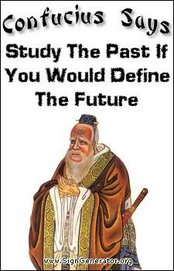Kris Kringle - Belsnickle - Nicholas in Furs
European influence of the 'santa claus' character started to show a new strand of information around 1820 in North America, beginning primarily in the Pennsylvania USA area amongst Dutch settlements. Kris Kringle was also known as Belsnickle, derived from the German "Pelz-Nickle" = "Nicholas in Furs." This influence didn't begin just in 1820 - it began much sooner, however, by 1820 we have an interesting development in the evolution of Santa Claus, and can pinpoint a strong trend in how Santa is 'visually' presented even to this day.
It is said that Belsnickle would travel around the Pennsylvanian countryside with bells in hand, treats bundled in a sack, and he was on the lookout for good children to give cakes and nuts (treats) to. If he came upon children who had been misbehaving throughout the year, he would warn them to be good next year, else they might earn a smack from his rod next year! This Belsnickle was basically a fatty-boy (plump), with red cheeks, and not so stern or bossy as some other 'Santas.' His interest was primarily in children, as well.
* Note - many other Euro-versions were similar but promoted 'goodwill' to families and all, some issued 'advice' or saved families by trying be anonymous in leaving gifts of gold, sacks of gold, etc. (one German St. Nicholas version has St. Nicholas leaving 3 bags of gold to a family where the father is distraught about having to send his daughters out to make money by prostitution or else lose all of the family belongings, their home, their stability in their community - this is SERIOUS Santa Clause SH*T! St. Nick saves the entire family by leaving a very considerable amount of gold - enough for at least two daughters to have a 'dowry' for marriages! Serious Santa Claus stuff, eh?). The "Belsnickle" version promoted by Dutch settlers is mostly seen giving 'fair warnings' about behaviors to CHILDREN. Belsnickle didn't seem as intent on providing gift solutions to entire communities, families, etc., as in other 'European' versions of the same figure.
Although of the 3 primary 'versions of Santa' (Kris Kringle, Santa, St. Nick), I searched for, 'Kris Kringle' searches yeilded the least 'decent' information, Belsnickle or Kris Kringle's 'motives' and 'appearance' seem to be the enduring points of "Santa Claus" that we are familiar with today!
Dutch influence promoting this 'Kris Kringle' seems to be what has given modern day "Santa" his 'jolly' tendency, including a 'plump,' robust appearance and red cheeks and nose. These points are typically the qualifications one needs to don "Santa gear" and work in the malls during the holiday season, or provide entertainment at Christmas parties as a rented "Santa" these days.
Dutch settlers who promoted the ideas of Kris Kringle may not have developed a strong 'mythology' or set of stories to go along with their 'significant version of santa,' however, the simplicity of and visual aspects of their version show up prominently today. Perhaps it wasn't that the Dutch didn't build mythology, but instead, relied on the already existing tales of Christkind, Kris Kringle, SinterKlaus, etc.
* this point requires more research, however, what is stated in the above paragraph is my best guess so far about how we've ended up with this very strong 'Dutch visual' requirement of Kris Kringle and how this has ended up as our present, enduring "Jolly, fat, red-cheeked Santa" that every North American child over the age of 2 is familiar with!
The larger idea of a gift-giving person who makes his rounds at a certain time of year certainly has a stronger set of 'stories' - mythological background - derived from very strong German sources, versus the 'Dutch version,' - however, the "German Kris Kringle" (or Christkind, Pelsnickle, Nikkolus, Nicholaus, etc) is typically very different in appearance than the 'form' that Dutch settlers pushed forward since the early 1800's.
It has already been an amazing journey I've begun into story origins on the topic of "Santa Claus." With respect to my previous post, I am truly convinced now that I was right when saying that research into this topic needs to start around February or March of the year in order to be well-rounded by the month of December!
Forgive my stumbling - I know there's more extensive information on the Dutch Belsnickle, as well, however, I haven't actually applied formal 'research methodology' and used the library yet. I have relied on Internet Resources, most of which are littered (of course) with sales pitches, everywhere that "Santa" is mentioned. Most sites are interested in providing a short, curt phrase or two on the most common 'Santa origins' - in order to ensure that Google Adsense will place decent advertising on the sites (or for other obviously 'commercial' motives). Then I am led to purchase an item and "Santa" information is obviously lacking from there on out!
I'll keep trying searches throughout the holiday season, but am now also interested in making this 'Search For Santa's Origins' part of an on-going project in the year 2009. I am interested to see if I will be able to dig up much better information and resources ONLINE once the holiday season is behind us. My guess is that more educational sites will turn up in search engine searches once "Christmas Season" has passed.
Currently, I have to conclude that the 'Coca-Cola Santa' gets his appearance from the Dutch Belsnickle, and also wonder if Coca-Cola's massive commercial influence hasn't also implanted long-lasting, very powerful visual images for us today that make us feel adamant that "Santa is a Jolly, red-cheeked, fat-boy - HO HO HO!"
Tuesday, December 23, 2008
Subscribe to:
Post Comments (Atom)












No comments:
Post a Comment